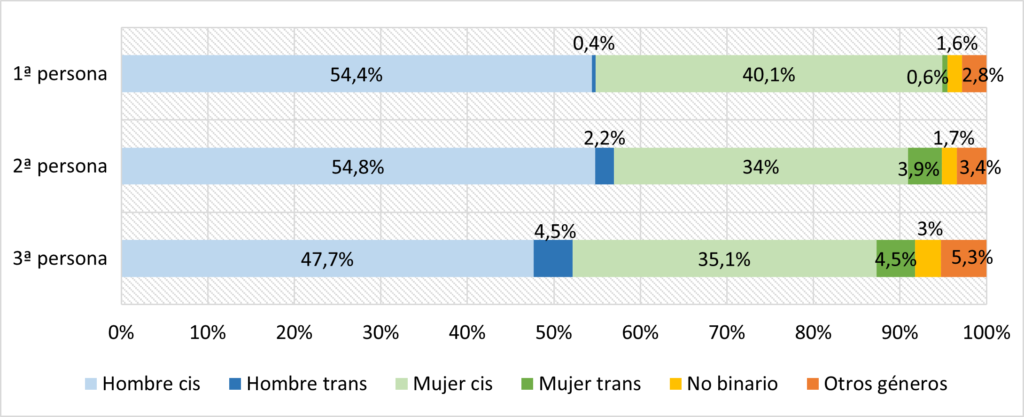Gender identity, influencers and adolescence
The first phase of the project involved a survey study among the youth population aged 14 to 17 in Galicia, in the Spanish context, and in Puebla in the Mexican context. For this purpose, an online questionnaire was designed with six sections: a general section on the use of social networks, four for each of the practices to be analysed (profile on the networks, selfies, memes, video clips) and one with socio-demographic questions. Data were collected during the school year 21-22.
The Galician study involved 1020 students living in urban, semi-urban and rural areas. The results provide an overview of the practices of adolescents on social networks and their relationship with their gender identity.
On the whole, adolescents in this age group are active in virtual environments. The most widespread social network is currently WhatsApp, as only 1.6% do not have an account on this app. YouTube, Instagram and TikTok all compete for second place, although it should be noted that in many cases, they have several accounts on the same network. The most striking case is Instagram, where more than half of the sample (56.1%) have at least two accounts. This shows their concern for the audience to which their posts are addressed. Thus, young people offer different images of themselves according to the context they are in. In the case of social networks, users have merged audiences and social contexts in a single space, generating a context collapse (Marwick and Boyd, 2014). This situation is circumvented by using different profiles that make it possible to display the socially desired image according to the target audience. In this sense, Livingstone (2008) points out in one of his studies that adolescents’ understanding of online privacy is less and less associated with the type of information they disclose and more and more with the people who have access to it.
Three out of four adolescents follow or admire a person of major interest on one of the social networks they use. A large proportion of these are friends, especially in the case of the person they admire first. Below them, there are people/characters who are more distant or alien (singers/musicians, athletes, influencers…).
Among cis men, the most repeated names belong to footballers or video game personalities, all of them men, except in the case of the name of a pornographic film actress, which appears in fifth place. While in the list of cis women there are influencers and singers, both men and women, it is, however, a man who appears in first place, as can be seen in Table 1, which shows those with the highest percentages.
Table 1. The five most-followed personalities, according to the gender of the student body
| Cis man | Cis woman | Non-binary | Other | ||||||||
| Fr. | % | Fr. | % | Fr. | % | Fr. | % | ||||
| Cristiano Ronaldo | 32 | 7.9% | Harry Styles | 18 | 3.8% | ElRubius | 1 | 4.0% | Lana Rhoades | 1 | 6.7% |
| Ibai Llanos | 28 | 6.9% | Aitana Ocaña | 12 | 2.5% | Billie Eilish | 1 | 4.0% | Harry Styles | 1 | 6.7% |
| Leo Messi | 28 | 6.9% | Auronplay | 11 | 2.3% | Melanie Martínez | 1 | 4.0% | Rebeca Stones | 1 | 6.7% |
| Auronplay | 11 | 2.7% | Marina Rivers | 11 | 2.3% | Robleis | 1 | 4.0% | Dulceida | 1 | 6.7% |
| Lana Rhoades | 7 | 1.7% | By Hermoss | 9 | 1.9% | Lana Rhoades | 1 | 4.0% | Louis Tomlinson | 1 | 6.7% |
Most of the people admired or followed are cisgender. The representation of non-normative options is notably low, although this percentage increases slightly as the position of the person followed decreases (Graph 1).
Graph 1. Gender of the three persons most followed by the students

It becomes clear that the influencers they follow correspond mostly to models of hegemonic masculinity and, in the case of women, clearly in line with female stereotypes, both linked to beauty standards and ideals based on a normative conception of femininity and masculinity, which is clearly in line with the study by Fedele et al. (2022), which points to the presence of traditional and hegemonic gender models in the content of the influencers most followed by Spanish teenagers. Such influencers reaffirm a stereotypical view of gender, rooted in a binary framework that conditions social reality itself (Butler, 2009).
These people/characters, as some studies point out, can function as role models through identification and admiration mechanisms (Aran-Ramspott et al., 2018; Ferchaud et al., 2018), which can therefore influence the construction of their gender identity at this stage.
Given these results, it is worth asking to what extent many of the actions on gender equality that are implemented in schools and colleges and other bodies are effective, given the time and power that social networks occupy in the daily lives of young people and the influence that influencers can exert as cultural, social and beauty references and as gender models, almost always stereotyped and constrained in the normative references of the feminine and the masculine, with little presence of other models.
References
Aran-Ramspott, S., Fedele, M., & Tarragó, A. (2018). YouTubers’ social functions and their influence on pre-adolescence. Comunicar, 26(2). https://doi.org/10.3916/C57-2018-07
Butler, J. (2009). Performatividad, precariedad y políticas sexuales. AIBR. Revista de Antropología Iberoamericana, 4(3), 321-336.https://www.redalyc.org/articulo.oa?id=62312914003.
Fedele, M., Villacampa, E., & Aran-Ramspott, S. (2022). Feminidad y masculinidad más inclusivas y respetuosas hacia el colectivo LGTBIQ. ¿Cómo representan los y las influencers españoles sus identidades de género?. ILCEA, (46). https://doi.org/10.4000/ilcea.
Ferchaud, A., Grzeslo, J., Orme, S., & LaGroue, J. (2018). Parasocial attributes and YouTube personalities: Exploring content trends across the most subscribed YouTube channels. Computers in Human Behavior, 80, 88-96. https://doi.org/10.1016/j.chb.2017.10.041
Livingstone, S. (2008). Taking risky opportunities in youthful content creation: teenagers’ use of social networking sites for intimacy, privacy, and self-expression. New media & society, 10(3), 393-411. https://doi.org/10.1177/1461444808089415
Marwick, A. E., & Boyd, D. (2014). Networked privacy: How teenagers negotiate context in social media. New media & society, 16(7), 1051-1067. https://doi.org/10.1177/1461444814543995

Authors
Esther Martínez-Piñeiro
Esther Vila-Couñago
Inés Ramos-Trasar
Grupo de Investigación Stellae
Universidad de Santiago de Compostela






